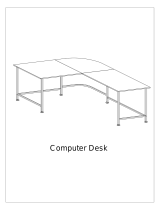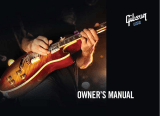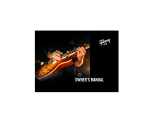Page is loading ...

5 String Banjo With Chrome Plated Hardware
PBJ60
www.pyleaudio.com
MAINTENANCE MANUAL

Now that you own a Pyle banjo, you will find that banjo maintenance will become a big
part of you being able to enjoy your banjo. Just as a car needs maintenance, gas, and
the engine tuned up, so your banjo needs to be tightened up and adjusted.
If you were to play your banjo without doing anything to maintain it, you would find that
soon it would be losing its quality of sound, rattling, and becoming harder to play.
Realize that your banjo is an instrument. It can't be left out in the sun, or in a hot car, or
taken out in freezing weather without it being damaged. If you want your banjo to keep
its value, you must maintain it. If you take good care of your banjo, it will last you a
lifetime and a be a treasure that you can pass on to future generations.
It isn't difficult to maintain your banjo, if you understand what needs to be done. There
are things that you need to do after each playing and things that only need doing every
few months, depending on how much you play. This maintenance manual will provide a
thorough outline of what you can do to keep your banjo as nice as it was the day you
bought it.
DAILY MAINTENANCE
1. The continued quality of your banjo is dependent on your daily efforts to maintain
it. It is best to develop a routine to do every time you put your banjo away. For
example:
2. Wipe the fingerprints and smudges off the metal parts with a clean cotton rag;
then run the cloth up and down the strings and fingerboard. If you don't wipe the
metal parts off, the acid from your skin will react with the metal and tarnish or eat
it away as time goes by. Keep a clean cloth in the case. (If you want a banjo that
won't tarnish, have your banjo Chrome plated, the Chrome is resistant to the
affects of the acid from your skin.)
3. Set your banjo in the case carefully so that you don't bump the fifth peg. After
several bumps the fifth peg might suddenly fall out.
The most important daily maintenance is to store your banjo in a hard-shell case.
This will protect it from being knocked around and insulate it against changes in
humidity and temperature.
CLEANING
Both wood and metal parts should be cleaned and polished every three to six months or more
often if needed to keep your banjo looking it's best.

FINGERBOARD CARE
To clean the fingerboard, rub it down with fret cleaner, then with a clean cloth rub the oil into the
wood, not leaving any excess on the fingerboard.
If you notice grooves in your frets, this is normal wear and tear, however if it happens within a
year you may be pressing harder than necessary when you fret the neck and may be creating
more fret wear than normal. Try using a lighter touch.
FINISH
Waxing the finish of the neck and resonator protects as well as shines it.
Avoid commercial furniture polishes containing harsh chemicals or silicone which can eventually
ruin the finish. If you spill water or alcohol on your banjo, wipe it off immediately because it can
leave a cloudy spot.
HEAD
If you prefer a clean head, use "Formula 409" or similar cleaner and a white cotton cloth.
METAL PARTS
The metal parts have a thin layer of chrome called "plating," which can be worn off. You can
polish chrome parts with an automotive chrome polish, not cleaner, but it is easy to get polish
caught under the hooks when you do this. You can use a clean polishing cloth to wipe
fingerprints off daily without harming the plating.
EFFECTS OF TEMPERATURE AND HUMIDITY
The survival of your banjo depends greatly on the environment you put it in. Made largely of
wood, the banjo is easily affected by changes in temperature and humidity. It is important then,
that you take all possible steps to maintain your banjo at room temperature If you must take
your banjo out in freezing temperatures, keep it in a case. When you bring it inside, let it sit in
the case so that it can come up to room temperature slowly.
Humid weather increases the moisture content of the wood, causing it to expand or swell. A
gradual increase in humidity won't generally do permanent damage; but high humidity in
combination with high temperature can weaken glue joints or even open them up.
A skin head tends to expand or loosen when the humidity rises, and tighten when the humidity
drops, considerably affecting the sound of the banjo. For this reason, it is best to tighten the
head annually depending on the weather of your area.
Sudden drops in local humidity are the most dangerous weather changes for a banjo. You
should keep a case humidifier in the case.

You will find that a couple of minutes now and then, making the needed adjustments, will
improve the sound immensely. It is to your advantage to become proficient at making
adjustments from the start.
CAUTION ABOUT DOING YOUR OWN ADJUSTMENTS
Before you start tinkering with your banjo, there is something you need to think about. What
happens if you break the truss-rod, a hanger-bolt or something? This is not uncommon when
someone completely new to banjo adjustments starts tinkering with his/her banjo.
A reputable repairman usually guarantees his work and repairs any mistakes he makes, or
replaces the instrument if he breaks it. If you break it, however, you will suffer the loss.
We recommend that before attempting any adjustments, you read this manual carefully, and
take your banjo to a reputable repairman. Watch him work on it and ask questions. So that next
time, you will be more familiar with how to do the adjustments yourself.
TIGHTENING THE HEAD
Your banjo should have a tight head in order to have its clearest tone. It should not be too tight
or the bass notes will be stifled.
BROKEN HEAD
A head can get brittle with age, so replacing a broken head is just part of owning a banjo.
CHANGING THE HEAD
If you're not confident in your ability to change the head correctly, please have a qualified
repairman do it for you while you watch, so that next time you will be prepared to do it yourself.
CHANGING THE STRINGS
The following sequence of steps will ensure that the bridge remains in the correct position and
your banjo stays in tune while changing the strings.
We recommend that you lightly mark the position of the bridge in pencil on the head, in case the
bridge falls over or is knocked out of place while changing the strings. This will save time in
repositioning the bridge.
Take one string off.
Rub pencil lead or a drop of oil into the nut slot to allow the string to slide more easily when
going into tune.
Re-tune the new string to the other strings on your banjo.
Continue the steps 1. through 3. for each successive string.

HOW TO THREAD STRINGS
The string is passed through the string hole near the top of the string post from the center of the
peg-head toward the edge of the peg-head.
The string is wound around the post in a direction away from the center of the peg-head. Pass
the free end under the attached string so the first wind is around the post above the string end.
The free end is then bent up and the string continues to be wound around the tuner post in the
same direction so the next wind goes under the string. This way the string is clamped between
two winds and will not slip. A string should pass around the shaft at least two full winds to clamp
it.
THE BRIDGE
Bridge placement is critical in getting the best possible sound from your banjo. There is a
specific place on the head where the bridge should sit for correct harmonic adjustment.
The size and design of the bridge will affect the sound of your banjo. Lowering the bridge
creates less pressure on the head and a sound loss results, the banjo becomes less responsive
and even muddy sounding.
Thinning the bridges reduces the weight and mass of the bridge to create a thinner, crisper or
less bass sound. Thinning the bridge too much can weaken the bridge.
HOW TO SET THE BRIDGE
1. For an approximate setting, place the bridge perpendicular to the strings - 26 3/16" from
the nut, in spite of the 26 1/4" fret scale length, because strings do not vibrate according
to the exact calculations of physics.
2. To get the bridge set precisely, use harmonics
TAILPIECE ADJUSTMENTS
The only adjustment on the tailpiece is via a screw which adjusts the tailpiece up or down
toward the head, affecting the string tension on the bridge.
For a crisp tone the tailpiece should be close to the head. Higher adjustment gives a more
mellow tone. Where you set the tailpiece is up to you. A good approximate setting is 1/8" off the
head. Always be sure that the tailpiece is anchored firmly to the tension hoop so it doesn't rattle.
TUNERS
If a tuner slips out of tune, just tighten it so it doesn't slip.
Be careful not to bump the fifth peg when handling your banjo or putting it into the case. After
several bumps the fifth peg can become loose and will suddenly fall out. If this occurs just put it
back in firmly.
If it falls out again, use "Tight Bond" to glue it back in.

IMPROVING BANJO SOUND
The banjo, more than any other stringed instrument, must be correctly adjusted to bring out its
best tone. Each adjustment is important to the overall sound of the banjo.
If your banjo doesn't have the sound it once had, you'll find this checklist helpful in restoring its
original life.
• New strings
• Hardware tight, no rattles
• Neck tight to the rim
• Head tight
• Tuner screws tight
• Bridge in place
• Tailpiece set
• Tuned to pitch
In addition to banjo adjustment, personal ability has a lot to do with banjo sound. The more you
practice, and improve your playing, the better your banjo will sound.
/


